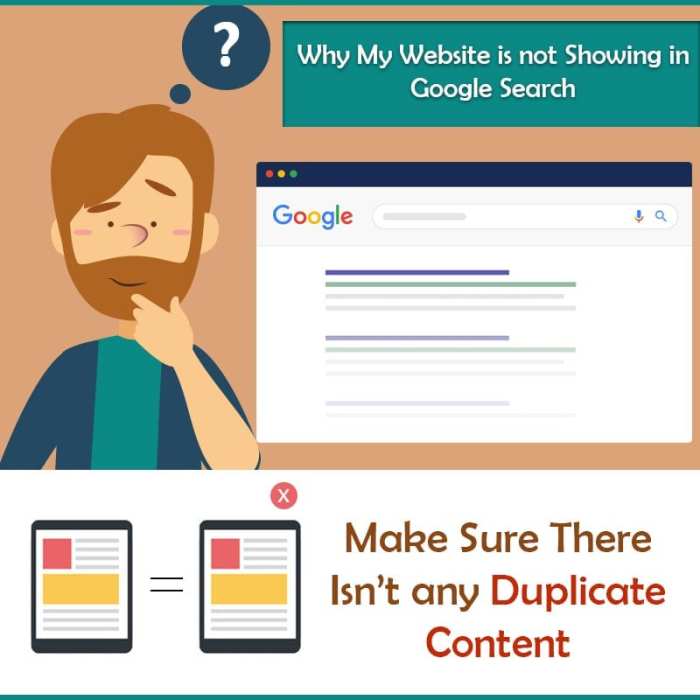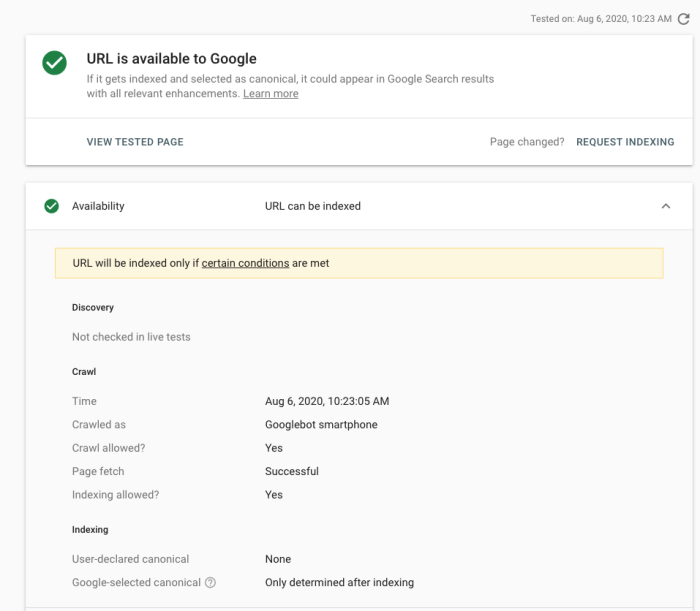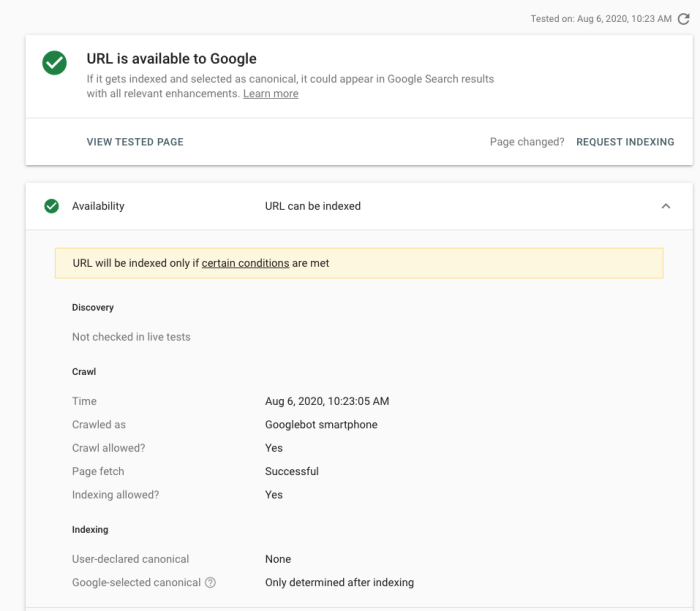Site not showing up on Google? This comprehensive guide delves into the multifaceted reasons behind this common WordPress issue. We’ll explore technical aspects, content optimization strategies, and off-page tactics to pinpoint the problem and implement effective solutions. From server errors to indexing problems, we’ll leave no stone unturned.
Understanding why your site isn’t visible in Google search results is crucial for its success. This in-depth analysis examines various factors impacting visibility, from technical glitches to content optimization errors. By understanding these components, you’ll be better equipped to diagnose and fix the issue.
Website Visibility Issues
A website’s visibility on Google search results is crucial for its success. Understanding the reasons behind a website’s absence from search engine results pages (SERPs) is vital for effective troubleshooting and improvement. This involves examining various technical and content-related factors that can hinder a website’s ability to be indexed and ranked.A lack of visibility can stem from several factors, from simple errors in website structure to more complex server-side issues.
Troubleshooting these problems requires a methodical approach, considering both the technical aspects of the website and the content it provides. Addressing these issues directly and systematically is key to restoring a website’s search engine visibility.
Common Reasons for Website Invisibility
Several factors can prevent a website from appearing in Google search results. These range from simple errors in website structure to more complex server-side issues. Understanding these reasons is the first step in fixing the problem.
- Server Errors and Downtime: Server issues, such as downtime, can prevent Google from accessing and indexing your website. This can be due to problems with your hosting provider, server maintenance, or unforeseen technical difficulties. If your server is frequently down or experiencing errors, Google may stop or delay indexing your site.
- Indexing Errors: Google’s crawlers need to be able to access and understand your website’s content. If there are errors in the website’s structure or configuration, crawlers may not be able to properly index the pages. These errors can range from missing robots.txt files to improper use of meta tags. For instance, a sitemap file with incorrect URLs or broken links will hinder the indexing process.
- Content Issues: Low-quality or duplicate content can negatively impact a website’s visibility. Search engines prioritize unique, high-quality content. If your content is thin, poorly written, or duplicates content from other websites, it may not be ranked highly, or at all.
- Technical Errors: Website technical errors, such as broken links, missing files, or incorrect redirects, can confuse Google’s crawlers and prevent them from properly understanding your website’s structure. This can range from simple typographical errors to complex issues with the website’s architecture.
Detailed Analysis of Indexing Issues
Identifying the specific indexing issues is crucial for targeted solutions. Analyzing the reasons behind a website’s absence from search engine results is a key step to successful resolution.
| Issue | Description | Potential Solutions | Impact |
|---|---|---|---|
| Server Errors | Problems with the server hosting the website, leading to downtime or inability for Googlebot to access the site. | Contact hosting provider, troubleshoot server issues, implement robust server monitoring. | Prevents indexing, lowers visibility, potential for penalties. |
| Indexing Errors | Googlebot cannot access or interpret website pages due to structural or configuration problems. | Fix broken links, ensure proper use of robots.txt, create a sitemap, use valid HTML, and ensure proper canonicalization. | Hinders visibility, prevents indexing of specific pages or the entire site. |
| Content Issues | Website content is thin, poorly written, or duplicates content from other websites. | Create high-quality, original content, optimize for user experience, remove duplicate content. | Low ranking, poor visibility, possible penalties. |
| Technical Errors | Broken links, missing files, incorrect redirects, or other technical issues preventing crawlers from navigating the website. | Fix broken links, ensure proper file structure, implement 301 redirects for moved pages. | Confuses Googlebot, prevents indexing, potentially leads to lower rankings. |
Off-Page Optimization Considerations
Off-page optimization is a crucial aspect of that focuses on activities outside your website to improve its search engine ranking. It’s about building your website’s authority and reputation in the eyes of search engines. By focusing on external factors, you indirectly enhance your website’s visibility and credibility, ultimately leading to higher organic search rankings.Off-page optimization goes beyond just stuffing and on-page adjustments.
Ever wondered why your site isn’t popping up on Google searches? It could be a myriad of factors, from technical SEO issues to outdated content. One area often overlooked is optimizing your Google Ads campaigns. Tools like AI-powered ad platforms and third-party creative generators, like those explored in the google ads ai vs third party tools comparison google ads creatives article, can significantly boost your visibility and drive traffic.
If your site is still invisible, a closer look at your ad strategy might just be the key to unlocking better search engine results.
It encompasses a range of strategies that demonstrate your website’s value and relevance to users and search engines. A robust off-page optimization strategy complements on-page efforts, creating a comprehensive approach to improving your site’s search engine visibility.
Backlink Building Strategies
Backlinks are essential for off-page optimization. They act as votes of confidence from other websites, signaling to search engines that your content is valuable and trustworthy. The more high-quality backlinks you have pointing to your site, the higher your search engine ranking potential.A critical aspect of backlink building is the quality of the linking websites. A link from a highly authoritative and relevant website carries more weight than a link from a low-quality or irrelevant site.
This prioritization of quality over quantity is key to successful off-page optimization.
Importance of Backlinks
High-quality backlinks are crucial for search engine rankings. They demonstrate the credibility and relevance of your website to search engines, ultimately leading to higher organic search results. This increased visibility leads to more organic traffic and higher conversion rates.
Ever wondered why your website isn’t popping up on Google search results? It could be a multitude of factors, but one often overlooked aspect is the importance of high-quality backlinks. Boosting your site’s visibility often hinges on strategies like contextual link building, which involves strategically placing links on relevant, authoritative websites. For a deeper dive into contextual link building four proven ways to get rank boosting links, check out this helpful guide.
contextual link building four proven ways to get rank boosting links. Ultimately, a strong online presence relies heavily on effective link building to get your site noticed by search engines.
Backlink Building Approaches, Site not showing up on google
Various strategies exist for building high-quality backlinks. These range from guest posting on relevant blogs to reaching out to influencers in your industry. Building relationships with other website owners and bloggers can lead to mutually beneficial link exchanges. Each approach requires careful consideration of the target audience and the overall strategy.
- Guest Blogging: Writing and publishing articles on other websites related to your niche. This allows you to showcase your expertise and gain exposure to a wider audience while creating backlinks.
- Broken Link Building: Identifying broken links on relevant websites and offering your own content as a replacement. This demonstrates helpfulness and strengthens your relationship with other sites, generating a backlink.
- Influencer Outreach: Collaborating with influential figures in your industry to promote your website or content. Their endorsement can lead to valuable backlinks and increased brand awareness.
- Directory Submissions: Listing your website on relevant online directories. This is a straightforward way to increase your online visibility and earn backlinks from reputable sources.
Comparing Backlink Building Approaches
Different backlink building approaches have varying levels of effectiveness. Guest posting, for example, can generate high-quality backlinks from authoritative websites, but it requires effort in content creation and outreach. Broken link building is a more targeted approach, focusing on providing value to other websites while earning a backlink. The most suitable approach depends on your specific goals and resources.
Social Media Influence
A strong social media presence can significantly impact your search engine visibility. Social signals, such as shares and likes, can indirectly influence search engine rankings. Regular engagement on social media platforms can enhance brand awareness, attract more potential customers, and build a strong online community. This, in turn, can contribute to a positive environment, ultimately enhancing your website’s visibility.
Off-Page Strategies
| Strategy | Description | Benefits |
|---|---|---|
| Guest Blogging | Publishing articles on other websites in your niche | High-quality backlinks, increased exposure |
| Broken Link Building | Identifying and replacing broken links on relevant websites | Demonstrates helpfulness, builds relationships, backlinks |
| Influencer Outreach | Collaborating with influential figures in your industry | Valuable backlinks, increased brand awareness |
| Directory Submissions | Listing your website on relevant online directories | Increased online visibility, backlinks from reputable sources |
| Social Media Engagement | Active participation on relevant social media platforms | Enhanced brand awareness, social signals influencing search engine rankings |
Troubleshooting and Diagnostics: Site Not Showing Up On Google
Websites disappearing from search results can be frustrating. Understanding the underlying causes and employing effective diagnostic techniques is crucial for restoring visibility. A systematic approach, encompassing technical checks and analysis of search engine signals, can pinpoint the root of the problem.A crucial aspect of website troubleshooting involves identifying the specific factors contributing to a website’s absence from search results.
This often requires a multifaceted approach that combines technical diagnostics, analysis of search engine signals, and evaluation of website content.
Common Problems Leading to Website Disappearance
Identifying the specific cause of a website’s disappearance from search results is paramount. Several common issues can contribute to this problem. Technical glitches, such as server errors or database malfunctions, can result in a website becoming inaccessible. Similarly, content issues, such as duplicate content or thin content, can harm a website’s search ranking. Finally, algorithmic changes implemented by search engines can impact a website’s visibility.
Importance of Checking Website Error Logs
Error logs are invaluable for diagnosing website problems. They record technical issues that might prevent a website from being properly indexed or displayed by search engines. Regularly reviewing these logs helps identify server errors, database issues, and other technical glitches that might be impacting search visibility. By analyzing error log entries, you can pinpoint specific problems and address them promptly.
Troubleshooting Checklist for Website Visibility Issues
A structured troubleshooting approach is essential for effective problem-solving. This checklist provides a systematic way to address website visibility issues:
- Verify website accessibility. Ensure the website loads correctly in different browsers and devices.
- Examine server error logs. Look for any error messages that might indicate technical problems.
- Analyze Google Search Console data. Identify any specific warnings or errors reported by Google.
- Check for content issues. Ensure the website’s content is unique, well-written, and relevant to the target audience.
- Review website structure. Verify that the website’s structure is optimized for search engines and user experience.
- Monitor changes in search engine algorithms. Stay updated on any significant changes in search engine algorithms that might affect the website.
Tools and Resources for Website Diagnostics
Several tools and resources can aid in website diagnostics. These tools provide insights into website performance and help pinpoint potential problems. Google Search Console is a valuable resource for identifying indexing issues, crawling errors, and other problems that might affect search visibility. Similarly, website performance monitoring tools offer valuable insights into website speed and responsiveness, which are crucial ranking factors.
Evaluating Website Technical Health
Evaluating a website’s technical health is critical for understanding its search visibility. A comprehensive evaluation should include factors such as website speed, mobile-friendliness, security, and site architecture. Tools such as Google PageSpeed Insights can help assess website performance. Additionally, checking for broken links and ensuring proper sitemaps are crucial to maintaining a healthy website. A website’s technical health significantly impacts search engine crawlers’ ability to effectively index and display its content.
Google Search Console Integration

Google Search Console is a free tool provided by Google that allows website owners to monitor and maintain their site’s presence in Google Search results. It provides invaluable insights into how Googlebot interacts with your website, offering crucial data for troubleshooting indexing issues and optimizing your site for search visibility. Understanding and utilizing Search Console is essential for anyone serious about improving their website’s organic search performance.Using Search Console is like having a direct line to Google’s crawlers.
It provides feedback on how Google sees your site, highlighting areas needing attention and revealing potential problems before they affect your search rankings. This proactive approach helps you maintain a healthy website presence and ensures your content is readily accessible to Google’s search algorithms.
Understanding Google Search Console
Google Search Console is a powerful tool for website owners. It acts as a bridge between your website and Google’s search engine. It provides comprehensive data on how Googlebot crawls and indexes your website. This information is crucial for understanding your site’s performance in search results. It also allows you to submit sitemaps and identify potential issues that may be hindering your site’s visibility.
Using Search Console for Website Diagnostics
Search Console offers a wealth of diagnostic tools to identify and address technical issues impacting your website’s performance. Through the “Index” section, you can discover crawl errors, mobile usability issues, and other potential problems. This proactive approach helps you maintain a healthy website presence and ensures your content is readily accessible to Google’s search algorithms.
Identifying Indexing Issues Using Search Console
The “Index” report in Search Console is a valuable tool for diagnosing indexing problems. It displays crawl errors, mobile usability issues, and other problems that may prevent your content from appearing in search results. Regularly checking this report helps you identify and resolve technical issues affecting your site’s indexing. Common issues include disallowed URLs, server errors, and issues with the site’s structure.
Submitting a Website to Google for Crawling and Indexing
Submitting your sitemap to Google Search Console is crucial for ensuring that Google can easily find and index all the important pages on your website. This process guides Googlebot to your website and its pages. This is a crucial first step to get your website listed on Google search.
- Sitemaps: Submitting a sitemap helps Google understand the structure of your website. A sitemap is a file that lists all the important pages on your website. This helps Googlebot efficiently crawl and index your site. You can submit your sitemap through the “Sitemaps” section in Search Console.
- URL Inspection: The URL Inspection tool allows you to submit individual URLs for immediate crawling and indexing. This is useful for checking if a newly added page or a recently updated page is being indexed. You can identify potential errors in the URL structure or content.
Monitoring Website Performance with Search Console
Regularly monitoring your website’s performance in Search Console is essential for maintaining visibility and addressing potential issues. The data collected from this tool can reveal trends and patterns in your site’s performance.
- Search Analytics: The Search Analytics report provides insights into how users are finding your website through Google Search. This includes search queries, impressions, clicks, and click-through rates. Tracking these metrics can reveal opportunities to improve your site’s content and relevance.
- Fetch as Google: This tool simulates how Googlebot sees your website. Using this feature, you can identify technical issues that might prevent Google from accessing your content. This is a valuable tool for diagnosing server errors or crawl errors.
- Index Coverage: The Index Coverage report provides a detailed view of how Google is indexing your site. It shows the URLs that have been successfully indexed, URLs that have been excluded from indexing, and the reasons behind the exclusion. This report is crucial for understanding potential indexing issues.
Competitor Analysis
Understanding your competitors is crucial for success in any online endeavor. A thorough competitor analysis provides valuable insights into their strategies, strengths, and weaknesses, ultimately helping you refine your own approach and improve your website’s visibility. This knowledge allows you to identify opportunities for improvement and tailor your efforts to stand out in the digital landscape.Analyzing competitors isn’t just about mimicking their successes; it’s about understanding the market dynamics and identifying gaps that your website can fill.
By dissecting their tactics, you can learn from their mistakes and leverage your own unique advantages to attract a larger audience. This process is an iterative learning experience, helping you adapt your strategies to achieve higher rankings and better visibility in search results.
Ever wondered why your website isn’t popping up in Google search results? A crucial first step in getting your site noticed is crafting a compelling landing page. Using landing page creation tools can significantly improve your site’s visibility. These tools often include SEO optimization features, helping to boost your site’s ranking. So, if your site isn’t showing up, consider investing in a well-designed landing page; it could be the key to getting your content discovered!
Identifying Competitor Strategies
Understanding your competitors’ strategies is essential for crafting a successful online presence. This involves examining various facets of their online approach. A systematic approach to this process is crucial for extracting actionable intelligence.
- Research: Analyzing the s your competitors are targeting reveals their content focus and audience appeal. Tools like SEMrush, Ahrefs, and Google Planner can help you identify relevant s.
- Content Analysis: Evaluating the quality and quantity of their content helps determine the types of content that resonate with their audience. Is it primarily blog posts, articles, or videos? Are they using various content formats effectively?
- Backlink Analysis: Examining the backlinks pointing to their website reveals the sources driving traffic to their site. Identifying the quality and quantity of backlinks is crucial for understanding their off-page optimization strategy.
- Technical Audit: Inspecting their website’s technical aspects, such as site speed, mobile-friendliness, and crawlability, gives you insight into their technical approach and potential areas for improvement on your own site.
- Social Media Presence: Evaluating their social media engagement reveals their approach to building brand awareness and driving traffic to their website. Identifying their social media channels and engagement strategies provides valuable insight into their audience interaction and content promotion.
How Competitor Analysis Improves Website Visibility
A well-conducted competitor analysis can illuminate several paths toward improving your website’s visibility. It offers a framework for strategic decision-making.
- Identify Gaps in the Market: By examining your competitors’ offerings, you can identify areas where your website can offer a unique value proposition, differentiating you from the competition. For example, a competitor might focus on high-end products, leaving a gap for mid-range options.
- Refine Strategy: Analyzing competitors’ targeting helps you identify gaps in your own strategy. Understanding their selection allows you to strategically target different s or adjust your existing ones to improve your ranking.
- Enhance Content Strategy: By understanding the type of content that resonates with their audience, you can create better, more engaging content for your own website. Observing their successful content formats and topics provides valuable direction.
- Optimize Technical : Identifying their technical shortcomings can highlight areas for improvement on your own site, leading to faster loading times, better mobile responsiveness, and improved crawlability.
- Develop a Strong Value Proposition: Competitor analysis provides valuable insight into how to create a stronger value proposition by recognizing the existing gaps and potential for innovation.
Sample Competitor Analysis Report
A comprehensive competitor analysis report includes key information that facilitates strategic decision-making.
| Competitor | Website URL | Strengths | Weaknesses | Opportunities | Threats |
|---|---|---|---|---|---|
| Example Company 1 | examplecompany1.com | Strong brand recognition, high-quality content | Slow website loading times, limited mobile optimization | Expand into new product categories, improve mobile optimization | Potential for new competitors entering the market |
| Example Company 2 | examplecompany2.com | Strong social media presence, active community engagement | Limited optimization, inconsistent content | Improve strategies, create more consistent content calendar | Potential for competitors to replicate their social media strategy |
Example Scenarios and Case Studies

Understanding why a website isn’t showing up in Google search results often involves a combination of factors. Sometimes, a simple oversight can be the culprit, while other times, more complex technical issues are at play. This section explores real-world scenarios to illustrate the potential causes and solutions.Identifying the root cause is crucial for effective troubleshooting. By examining specific examples, we can better understand how to diagnose and resolve website visibility problems.
Scenario 1: Website Content Issues
A new e-commerce store, “FreshProduceDirect.com,” launched its website with a focus on organic produce. However, despite consistent content updates, the site didn’t appear in Google search results.
The website’s content, though relevant to its niche, lacked sufficient optimization. Crucially, the site lacked optimized product descriptions, meta descriptions, and header tags. This led to poor search engine crawlability and indexing. Furthermore, the site’s content was not unique; many similar phrases were used across different pages.Solutions to resolve this scenario include:
- Implementing thorough research to identify relevant search terms for organic produce.
- Creating unique and high-quality product descriptions that highlight key features and benefits.
- Optimizing title tags and meta descriptions for each page, incorporating identified s.
- Ensuring unique content across all product pages, avoiding duplicate content issues.
- Regularly updating content with fresh, informative, and engaging material.
Scenario 2: Technical Server Problems
A blog, “TechInsights.com,” experienced a sudden disappearance from search results. The blog had been consistently updated and was generating traffic previously.
The underlying server hosting the blog experienced technical issues. Specifically, there were problems with server response times, which significantly impacted the ability of Googlebot to crawl and index the site. Furthermore, there may have been intermittent downtime or a configuration error related to sitemap submission, leading to a loss of visibility.Solutions to resolve this scenario include:
- Contacting the hosting provider immediately to identify and resolve server issues.
- Monitoring server response times and uptime through tools and services.
- Validating that the sitemap is properly submitted and updated in Google Search Console.
- Implementing caching mechanisms and other performance optimization strategies to improve loading speed.
Scenario 3: Penalty from Google
A website, “LuxuryWatchesOnline.com,” a retailer of luxury watches, lost its ranking after a period of high traffic and growth.
The website was likely penalized by Google due to violations of its webmaster guidelines. Specifically, “LuxuryWatchesOnline.com” might have engaged in practices such as stuffing, paid link schemes, or cloaking, which negatively impacted their ranking. This is common in cases where the website is engaging in spammy or deceptive tactics.Solutions to resolve this scenario include:
- Identifying the specific reason for the penalty by reviewing Google Search Console reports and alerts.
- Understanding the Google Webmaster Guidelines and implementing necessary changes to comply with these standards.
- Removing any spammy or manipulative links or content.
- Building high-quality backlinks from reputable websites to increase site authority.
- Requesting a reconsideration of the penalty from Google, providing evidence of compliance with their guidelines.
Ending Remarks
In conclusion, recovering a missing website from Google’s search index involves a multi-pronged approach. We’ve covered everything from technical troubleshooting to Google Search Console integration and competitor analysis. Remember, consistent effort and a deep understanding of the issues are key to reclaiming your site’s visibility and driving traffic. By following the strategies Artikeld in this guide, you can identify and resolve the reasons your site isn’t showing up in search results, thereby increasing its online presence and ultimately, its success.






